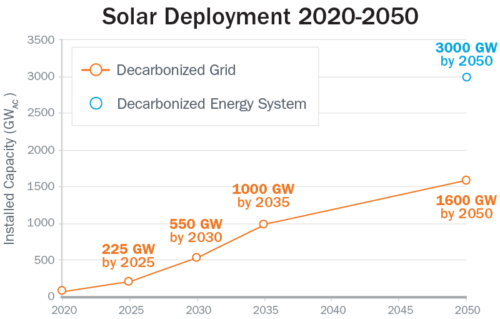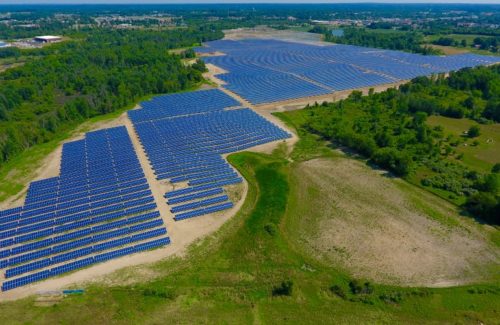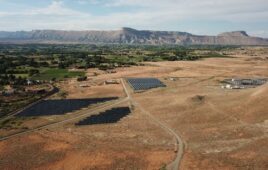
The Solar Futures Study modeled the deployment of solar necessary for a decarbonized grid. Preliminary modeling shows that decarbonizing the entire energy system could result in as much as 3,000 GW of solar due to increased electrification.
The U.S. Department of Energy (DOE) today released the “Solar Futures Study,” detailing the significant role solar will play in decarbonizing the nation’s power grid. The study shows that by 2035, solar energy has the potential to power 40% of the nation’s electricity, drive deep decarbonization of the grid, and employ as much as 1.5 million people — without raising electricity prices. The study’s findings call for massive and equitable deployment of clean energy sources, underscoring the Biden Administration’s efforts to tackle the climate crisis and rapidly increase access to renewable power throughout the country.
“The study illuminates the fact that solar, our cheapest and fastest-growing source of clean energy, could produce enough electricity to power all of the homes in the U.S. by 2035 and employ as many as 1.5 million people in the process,” said Secretary of Energy Jennifer M. Granholm. “Achieving this bright future requires a massive and equitable deployment of renewable energy and strong decarbonization polices — exactly what is laid out in the bipartisan Infrastructure Investment and Jobs Act and President Biden’s Build Back Better agenda.”
In 2020, the U.S. installed a record amount of solar — 15 GW — to total 76 GW, representing 3% of the current electricity supply. The Solar Futures Study, prepared by DOE’s National Renewable Energy Laboratory, shows that, by 2035, the United States would need to quadruple its yearly solar capacity additions and provide 1,000 GW of power to a renewable-dominant grid. By 2050, solar energy could provide 1,600 GW on a zero-carbon grid — producing more electricity than consumed in all residential and commercial buildings in the country today. Decarbonizing the entire energy system could result in as much as 3,000 GW of solar by 2050 due to increased electrification in the transportation, buildings, and industrial sectors.
The study lays out the blueprint for achieving this milestone, which requires strong decarbonization polices coupled with a massive deployment of renewable energy sources, large-scale electrification, and grid modernization. The study’s key findings include:
- A clean grid requires massive, equitable deployment of diverse, sustainable energy sources — The U.S. must install an average of 30 GW of solar capacity per year between now and 2025 and 60 GW per year from 2025-2030. The study’s modeling further shows the remainder of a carbon-free grid largely supplied by wind (36%), nuclear (11%-13%), hydroelectric (5%-6%) and biopower/geothermal (1%).
- A decarbonized power sector will create millions of cross-sector jobs — The study modeling shows that solar will employ 500,000 to 1.5 million people across the country by 2035. And overall, the clean energy transition will generate around 3 million jobs across technologies.
- New tools that increase grid flexibility, like storage and advanced inverters, as well as transmission expansion, will help to move solar energy to all pockets of America – Wind and solar combined will provide 75% of electricity by 2035 and 90% by 2050, transforming the electricity system. The deployment of storage enables more flexibility and resilience, growing from 30 GW to nearly 400 GW in 2035 and 1,700 GW in 2050. Advanced tools like grid-forming inverters, forecasting and microgrids will play a role in maintaining the reliability and performance a renewable-dominant grid.
- A renewable-based grid will create significant health and cost savings – Reduced carbon emissions and improved air quality result in savings of $1.1 trillion to $1.7 trillion, far outweighing the additional costs incurred from transitioning to clean energy. The projected price of electricity for consumers does not rise by 2035, because the costs are fully offset by savings from technological improvements.
- Supportive decarbonization policies and advanced technologies are needed to further reduce the cost of solar energy — Without some combination of limits on carbon emissions and mechanisms to incentivize clean energy, the U.S. cannot fully decarbonize the grid — models show that grid emissions fall only 60% without policy. Continued technological advances that lower the cost of solar energy are also necessary to enable widespread solar deployment.
News item from the U.S. Department of Energy






“The U.S. Department of Energy (DOE) today released the “Solar Futures Study,” detailing the significant role solar will play in decarbonizing the nation’s power grid. The study shows that by 2035, solar energy has the potential to power 40% of the nation’s electricity, drive deep decarbonization of the grid, and employ as much as 1.5 million people — without raising electricity prices.”
The DOE of all bureaucracies is skewed here in their study. When talking the power grid, it is being accepted that means the utility scale energy generation that affects prices on the wholesale energy market, but does NOT have a large effect on the retail electricity costs. The IOU electric utilities are “allowed” by law to an “assured” rate of return. This means these entities are “allowed” filing electricity rate increases if the utility doesn’t sell as much electricity as they used to, referred to as a rate case for “lost revenues”. These IOU utilities also get preference of filing a rate case when old fueled generation plants are decommissioned and there are “stranded assets”. Yes, it is good one can install large scale solar PV and wind farms in the GW generation range and even drive down wholesale electricity rates to 1 cent/kWh; $10MWh generated. This will not make that much difference in the retail electricity rate. To reach this 40%, 50%…80% decarbonization of the grid is going to start at about 4% retail electricity increase (per year) every year for the next 10 years. Meaning on average, retail electricity rates will increase such that an electric bill of $200/month will cost a ratepayer, $280/month for the same electricity use in 2030. That last 20% will cost much more and become more difficult to implement in the grid, I do not see retail electricity rate declines until there’s about 25% excess energy is stored than the country as a whole needs every day. Without excess on tap, just in time will become a more expensive alternative in a system that could only be described as EaaS, Energy as a Service.
“A clean grid requires massive, equitable deployment of diverse, sustainable energy sources — The U.S. must install an average of 30 GW of solar capacity per year between now and 2025 and 60 GW per year from 2025-2030. The study’s modeling further shows the remainder of a carbon-free grid largely supplied by wind (36%), nuclear (11%-13%), hydroelectric (5%-6%) and biopower/geothermal (1%).”
Once again, it all depends where this energy generation is installed. It seems to be a “practice” that residential, small business, even C&I solar PV systems and energy storage are not added to the tally sheet. IF one uses the 2016 NREL Lidar study for solar roofs in the U.S. there are about 67 million solar PV viable roofs and of these some are large 25,000 to 1,000,000 square feet of available panel space. Many are smaller homes with less than 5,000 square feet of roof space. With ‘just’ 600 square foot of roof space available, one could install about 10kWp on 67 million roofs, just a conservative assumption of (4) sun hours a day average, you could generate, 2.68TWh a day in just those four sun hours. Adding energy storage of ‘just’ 20kWh to these 67 million systems, leaves one able to control another 20kWh per home “as needed” every day. Solar PV and energy storage is the (most) efficient installed on the (property) of the building it will power.